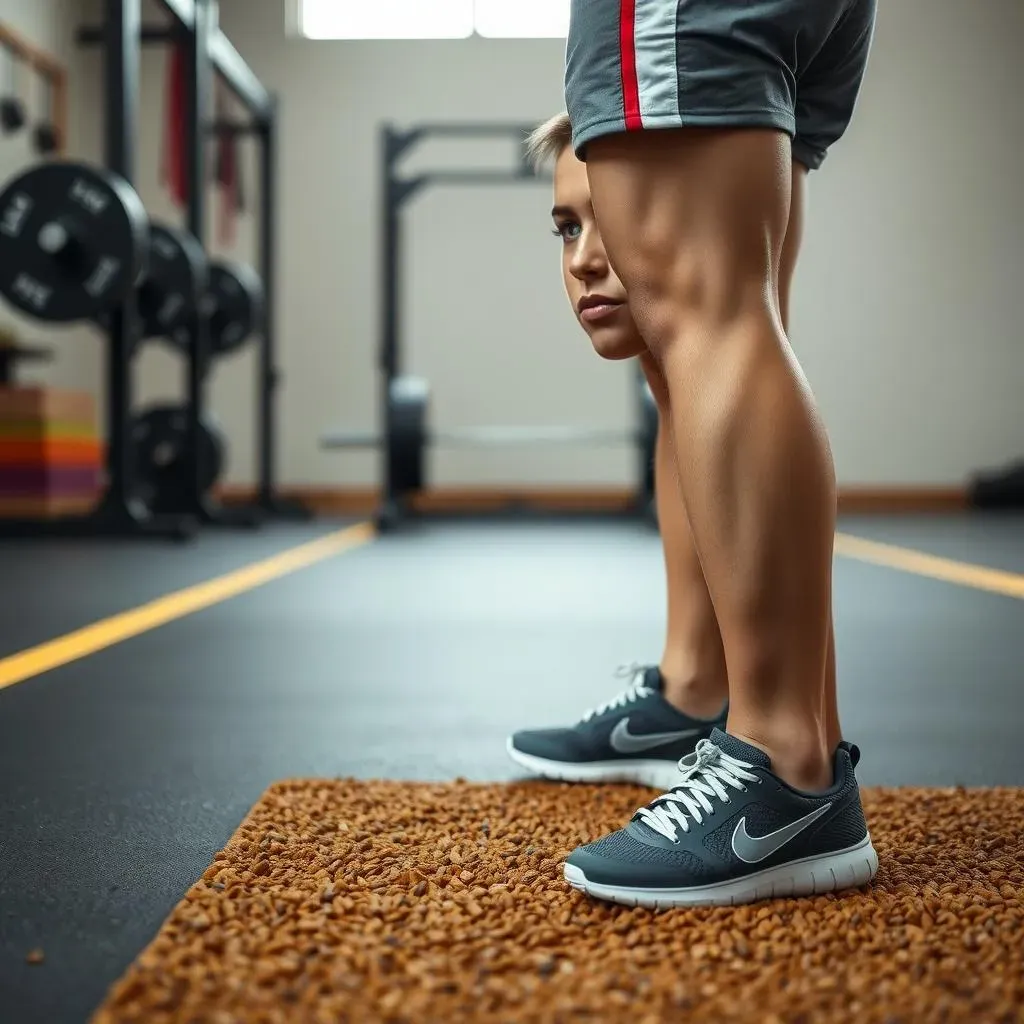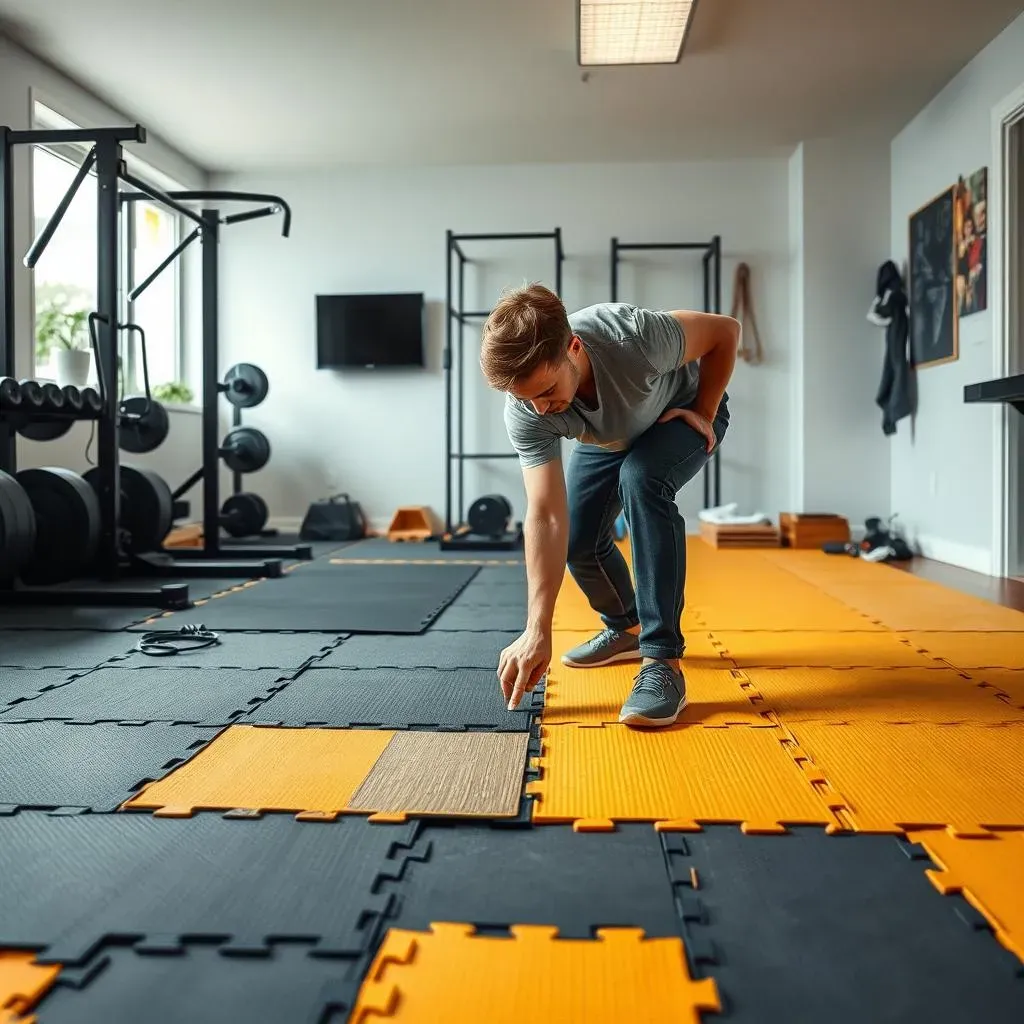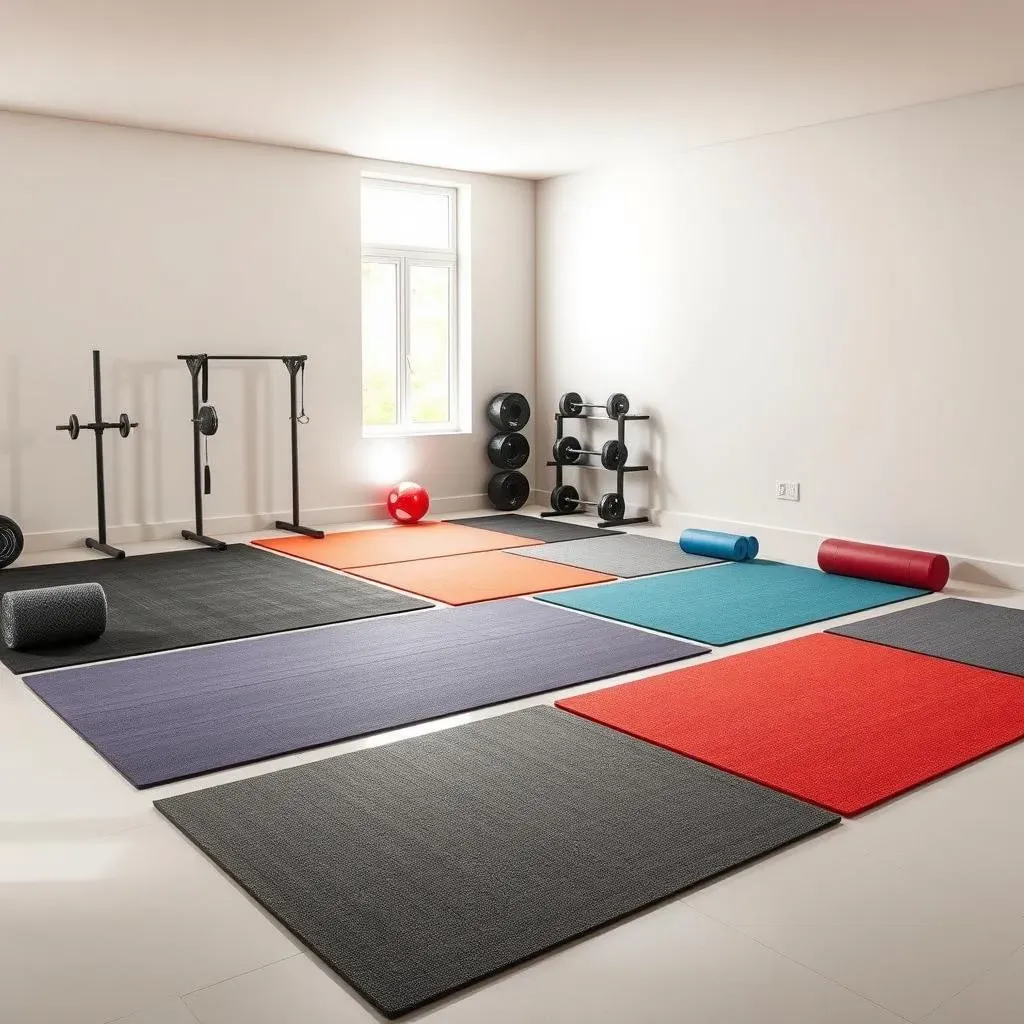Table of Contents
Ever dropped a dumbbell and watched your floor cringe? Or maybe your treadmill’s been doing a jig across the room during your cardio session? That's where floor mats for home gym equipment swoop in to save the day (and your floors). We're not just talking about any old mats; we're diving into the world of durable, slip-resistant surfaces that can handle your toughest workouts. These aren't just about protecting your floors; they're about creating a safer, more stable, and dare I say, more enjoyable workout space. Think of them as your gym's unsung heroes. In this guide, we'll walk you through why these mats are essential, how to choose the perfect ones for your needs, and how to keep them in top shape. We'll even cover some tips to maximize your workout experience. So, if you're ready to say goodbye to floor damage and hello to a more secure workout, let's get started.
Why Your Home Gym Needs Floor Protection Mats
Why Your Home Gym Needs Floor Protection Mats
Protect Your Floors From Workout Mayhem
let's be real. Your home gym isn't exactly a delicate flower. It's a place where weights drop, feet pound, and sometimes, things just go flying. Without the right protection, your floors could end up looking like they've been through a demolition derby. Scratches, dents, cracks – these are all potential souvenirs from your fitness journey if you skip out on floor mats. Think about it, those heavy dumbbells you love? They're not exactly gentle on hardwood or tile. A good mat acts like a shield, absorbing impact and preventing damage. It's like giving your floor a cozy, padded suit of armor. Plus, who wants to spend their workout worrying about messing up the floor? Not me, and certainly not you.
Safety First: Preventing Slips and Slides
Now, let's talk safety. A slippery floor is a recipe for disaster. One wrong step during a burpee, and you could be headed for a painful tumble. Floor mats, especially those with non-slip surfaces, are like a safety net for your workouts. They provide the grip you need to stay planted during even the most intense exercises. Whether you're doing plyometrics, yoga, or just lifting weights, a good mat keeps you stable and reduces the risk of slips and falls. And let’s not forget about the sweat factor; those beads of perspiration can make even the sturdiest floors treacherous, good floor mats will help keep you safe. It’s all about creating a workout environment where you can push your limits without worrying about losing your footing. You're not a figure skater, you're trying to get fit!
Benefit | Description |
|---|---|
Floor Protection | Prevents scratches, dents, and cracks from heavy equipment and weights. |
Enhanced Safety | Provides a non-slip surface, reducing the risk of falls and injuries. |
Noise Reduction | Absorbs impact and dampens noise from dropped weights and equipment. |
Noise Reduction and a More Pleasant Workout
Let's not forget about the noise. Dropping weights can be loud, like, really loud. And if you live in an apartment or have family members who aren't thrilled about your early morning workout sessions, noise can be a real issue. Floor mats help to absorb the impact and dampen the sound, making your workouts quieter and more considerate to those around you. It's about creating an environment where you can focus on your fitness without disturbing everyone else. Plus, a less noisy workout can be a more pleasant workout. No more cringing every time a weight makes contact with the floor. You can focus on the burn, not the bang. It’s a win-win for everyone.
Choosing the Best Floor Mats for Your Gym Equipment
Choosing the Best Floor Mats for Your Gym Equipment
Material Matters: What Your Mats Are Made Of
so you're ready to get some floor mats, but hold up a second, not all mats are created equal. The material is a big deal. You've got your foam mats, which are usually cheaper and comfy for bodyweight stuff but might not hold up to heavy weights. Then there's rubber, which is like the tough guy of floor mats. It's durable, slip-resistant, and can handle a serious beating. SBR rubber granules are where it's at if you want the best of both worlds – good shock absorption, slip resistance, and they last a long time. Don't get me wrong, foam has its place for yoga and stretching, but for serious gym equipment, rubber is generally the way to go. It's like the difference between a paper plate and a ceramic one; one is going to handle your steak a whole lot better.
Thickness and Density: Finding the Right Fit
Now, let's talk about thickness and density. It’s not just about how squishy the mat is, it’s about how well it’s going to protect your floor and how stable your equipment will be. A thin mat might feel nice under your feet, but it won't do much to cushion heavy impacts. You want something that's thick enough to absorb the shock of dropped weights but not so thick that it becomes wobbly. Density is also crucial; the denser the mat, the better it’ll be at handling weight and pressure. We're aiming for something with a density of at least 1,000 kg/m3. It's like choosing the right mattress – too soft, and you sink in; too hard, and you might as well sleep on the floor. You want that sweet spot in the middle for optimal performance.
Material | Pros | Cons | Best For |
|---|---|---|---|
Foam | Comfortable, inexpensive | Not very durable, less shock absorption | Light workouts, bodyweight exercises |
Rubber | Durable, slip-resistant, good shock absorption | More expensive, can be heavy | Heavy equipment, weightlifting |
SBR Rubber Granules | Very durable, high shock absorption, slip-resistant | Can be more expensive, but worth it | All types of equipment, high-intensity workouts |
Non-Slip Surface and Other Important Features
let's talk about grip. You don’t want your mat to be sliding all over the place while you're trying to do a set of squats. A good non-slip surface is a must-have. Look for mats with a slip resistance value of ≤105 PTV. That means it’s been tested for grip, and it won’t let you down. Other things to consider? How easy is it to install? Can you adjust the mats to fit your space? And how easy are they to clean? You don't want to be spending your precious workout time scrubbing down your mats. Look for something that’s low-maintenance and functional. It’s about making your workout space as convenient and safe as possible. It's like choosing the right shoes; you want something that supports you and doesn't get in your way.
Installing and Maintaining Your Gym Floor Mats
Installing and Maintaining Your Gym Floor Mats
Planning Your Space: Layout and Preparation
so you've got your mats, but before you just throw them down, let's think about your space. Planning your gym layout is key. Where will your equipment go? How much space do you need for your workouts? It's like Tetris, but with weights and treadmills. Measure your area, sketch out a plan, and figure out how many mats you'll need. Don't forget to prep the floor beneath. You want a clean, level surface to start with. Sweep or vacuum, and if you've got any uneven spots, try to level them out, or those mats will be wonky. It’s all about setting yourself up for a successful workout space. It's like laying the foundation for a house; you want it to be solid.
The Installation Process: Putting the Pieces Together
Now for the fun part—laying down the mats. Most floor mats for home gym equipment come in interlocking tiles or rolls, which are pretty straightforward to install. Start in one corner and work your way across, pushing the pieces together firmly. If you've got tiles, make sure they're aligned properly, or you'll end up with a wonky-looking floor. For rolls, cut them to fit your space, and use tape if needed to secure the edges. It’s like putting together a giant puzzle, except this one is actually useful. Double-check that everything is snug and there are no gaps, and you're good to go. If you're having trouble, grab a friend. Teamwork makes the dream work.
Step | Description |
|---|---|
1. Measure | Measure your gym area and plan your layout. |
2. Prepare | Clean the floor and ensure it’s level. |
3. Lay Mats | Start in one corner, interlocking or rolling out the mats. |
4. Secure | Make sure all mats are snug and use tape if needed. |
Maintenance: Keeping Your Mats in Top Shape
So, the mats are down, and your gym looks awesome. Now, it’s time to talk about keeping them that way. Regular cleaning is crucial. Wipe down your mats with a damp cloth or mop after each workout to remove sweat and dirt. For a more thorough cleaning, use a mild soap and water solution. Avoid harsh chemicals, as they can damage the mats. And if you have mats made of foam or rubber, avoid prolonged exposure to direct sunlight, as it can cause fading and deterioration. Treat your mats well, and they'll treat you well. It's like taking care of your car; regular maintenance keeps it running smoothly. A little effort goes a long way in extending the life of your gym floor mats.
Maximizing Your Workout with the Right Floor Mats
Maximizing Your Workout with the Right Floor Mats
Creating Zones for Different Activities
Alright, so you've got your floor mats down, but let's take it to the next level. Think of your gym as a mini fitness playground, and your mats are the boundaries between different zones. You can use different colored mats or even different mat types to designate specific areas. Maybe you have a thick, dense mat for your weightlifting zone, a softer foam mat for your stretching area, and a non-slip rubber mat for your cardio. This helps you mentally separate your workouts, making transitions smoother and your training more focused. It’s like having a well-organized kitchen; everything has its place, making the whole process more efficient and enjoyable. Plus, it just looks cooler and more professional, right? It's not just about throwing down some mats; it's about creating a space that works for you.
Now, let's get creative. You can use your mats to mark out specific areas for drills or circuits. For example, you could use tape to mark a box on your mat for jump squats or a line for lateral movements. This not only adds a visual element to your workouts but also helps you stay precise and consistent. It's like having a personal trainer guiding you through your routine. And if you're into calisthenics, you can use different mat placements to challenge yourself with handstand practice or other bodyweight exercises. It’s about maximizing the potential of your space and turning your home gym into a dynamic and versatile training area. Think of it like setting the stage for your own fitness performance.
Specialized Mats and Cushioning for Enhanced Training
let's talk about taking your floor mat game up a notch. You know, beyond just the standard mats? Sometimes, you need a little extra oomph, especially for high-impact activities or if you have sensitive joints. That's where specialized cushioning mats come in handy. These aren’t your typical floor mats; they’re designed to provide extra support and shock absorption. Think of them as the memory foam mattresses of the gym world. If you're doing a lot of plyometrics or have a history of knee issues, these mats can make a huge difference in reducing strain and preventing injuries. They're like having a personal shock absorber under your feet, giving you the confidence to push harder without worrying about the impact. It's all about training smarter, not just harder.
And it's not just about cushioning; it's also about stability. Some specialized mats have textured surfaces or added grip to ensure you stay grounded during your workouts. This is especially important for exercises like yoga or Pilates, where balance is key. You want a mat that supports your body and helps you maintain proper form. Think of it like the tires on a race car; they provide the traction and stability you need to perform at your best. So, if you're looking to elevate your training, consider investing in some specialized mats. It's a small investment that can make a big difference in your performance and overall well-being. It’s like adding a turbocharger to your fitness routine.
Mat Type | Purpose | Benefits |
|---|---|---|
Standard Rubber Mats | General floor protection | Durable, slip-resistant, good for most exercises |
Cushioning Mats | High-impact activities, joint support | Extra shock absorption, reduces strain, provides comfort |
Textured Mats | Yoga, Pilates, balance exercises | Enhanced grip, improved stability, better form |
Wrapping Up: Your Floor Mat Journey
So, there you have it – the lowdown on floor mats for home gym equipment. These aren't just slabs of rubber; they're essential for protecting your home, improving your workouts, and keeping you safe. From choosing the right material to proper installation and maintenance, it’s all about making smart choices that support your fitness goals. Remember, a well-protected gym floor isn't just about avoiding damage; it's about creating an environment where you can push your limits without worry. Now, go forth, equip your home gym wisely, and get ready to sweat it out on a surface that's got your back (and your floors!).